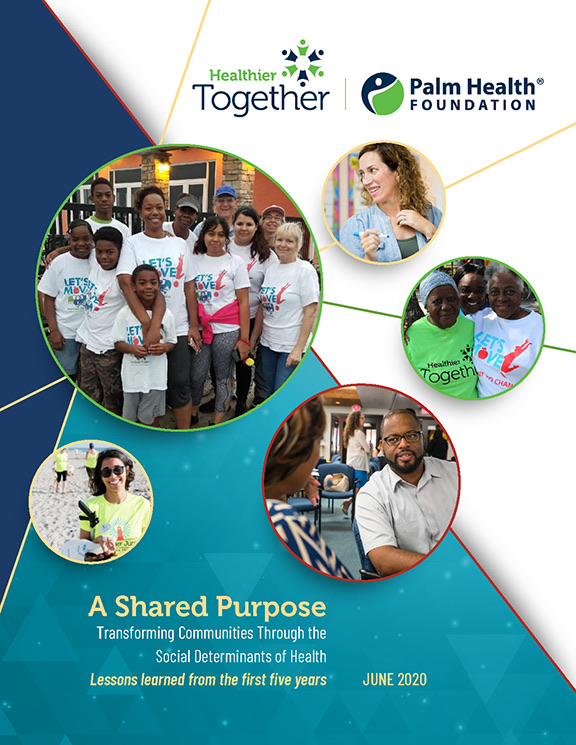our work
Community Readiness
Healthier Together approaches complex health problems by targeting root causes, creating strong relationships, planting deep roots and working hand-in-hand with residents to generate change from the inside out.
Early on, Palm Health Foundation learned that we were not fully prepared for the complexity of the issues in the neighborhoods, complicated power dynamics and the time and effort that would be required to build trust in the neighborhoods where the work would be done.
At the same time, residents were wary of the foundation. There was confusion, doubt and skepticism early on as we and our community partners tried to explain the potential for Healthier Together and ask for the residents’ participation. The $1 million in funding was certainly an enticement, but many wondered, “What’s the catch?”
It became apparent that the foundation needed outside assistance to understand how to transition from a traditional grantmaking model to community-change work and work toward authentic community participation. Several consulting groups with specific areas of expertise were hired to help roll out Healthier Together, a paradigm shift for the organization.
• Action Evaluation Collaborative: Introduced participatory evaluation techniques and tools, which continue to be incorporated today. Their work, grounded in movement making and social justice principals, emphasized transparency and accountability in relationship to power dynamics, and helped the foundation reflect deeply on how they are evidenced in the work.
• Ronik-Radlauer Consulting Group: Introduced Results-Based Accountability – What do we know, how do we know it, and what are we going to do?
• Robertson Consulting Group: Provided facilitation and design work leading to “the changes we want to see” framing as well as a structure for a learning plan.
• Health Council of Southeast Florida: Offered refinement of the “wins” process and use of results-based accountability, and provided critical case making for working in complexity and how this approach impacts evaluation efforts.
• Tenacious Change: Shared a Theory of Change for collective change leadership with insight on realistic time horizons and key process elements, which informed the readiness, growth and transformation signals.
• Tamarack Institute: Throughout the Healthier Together initiative, Tamarack has offered key counsel as well as practical and applied tools and approaches for systems change while in meaningful partnership with community members most impacted by societal challenges.
• Converge and Associates: Helped to increase accountability within the foundation and among the Healthier Together communities to be rigorous in pursuing a community-led decision-making process.
• Impact Illustrated: Developed and implemented novel methods for reporting the results of a complexity-informed evaluation and sharing vast amounts of rich, narrative data directly with the community and decision-makers. The foundation applies concepts to Healthier together mini-grants, SenseMaker projects and other significant social change undertakings.
• Florida Center for Cultural Competence: Contributor to the community appraisal process before the Healthier Together initiative was launched and resource for workshops and training on areas related to culture, race and understanding.
• Wright Ideas Unlimited: Contributor to the community appraisal process before the Healthier Together initiative was launched and early advisors in the planning stages.
A Data-Informed Process
Selection of the Healthier Together Communities
Selection of the six Healthier Together communities was a data-informed process that highlighted concentrated areas throughout Palm Beach County with low health indicators, gaps in services and high-risk factors impacting residents’ ability to live healthy lives.
A comprehensive community appraisal process was conducted engaging various community leaders, influencers and stakeholders in communities where health indicators revealed the greatest needs. Through this appraisal process, neighborhood narratives began to emerge and shape the foundation’s understanding of each community and its natural assets including a history of collaboration and collective action in those communities.
Specific questions helped to evaluate a community’s capacity for action:
To what degree does a community have the capacity and willingness to take action on and/or a sense of urgency on whatever issues are of concern to their communities?
Do they have organizations and alliances/networks with other community-based organizations across sectors locally, regionally and nationally who share similar aspirations for the community and a willingness to explore solutions with non-traditional decision-makers?
Do they have formal and informal leadership interested and willing to tackle issues impacting their community, and are they open to a process for ongoing leadership development in the community?
Is there energy and momentum for potential contributions to the process of policy change/policy making?
Given support and resources, are they able to take part in decision-making and systemic change, advocating for and representing their own interests, concerns and goals?
From what we have learned so far, we have identified the following key components to assess a community’s readiness for change:
Healthier Together Recipe for Community Readiness
- Solid project director respected by the community to provide day-to-day support and serve as ambassador
- Residents and resident leaders committed to collaboration
- Fiscal agent that is an anchor in the community to serve as convener and manage budget
- Consensus on health priority
- Conviction for taking first action

